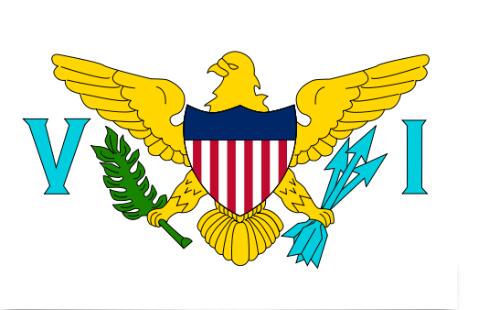U.S. Virgin Islands Flag and Meaning
Flag of U.S. Virgin Islands

U.S. Virgin Islands Flag Meaning
The US Virgin Islands flag consists of the United States National Bird, an eagle on a white background. The eagle holds a twig in one clone and three arrows in the other. The emblem of the United States can be seen on the chest of the eagle. On each side of the eagle are the letters V and I, which stand for the Virgin Islands’ American name, Virgin Islands.
U.S. Virgin Islands Overview
| Population | 102000 |
| Currency | US $ |
| Area | 347 km² |
| Capital city | Charlotte Amalie |
| Population density | 293.9 residents/km² |
The western part of the Virgin Islands archipelago, just east of Puerto Rico. The area consists of 3 main islands: Thomas, St. John and St. Croix, as well as about 100 uninhabited small islands. The islands are of volcanic origin and are mountainous. The climate is tropical, but the irregular rainfall makes farming difficult. At St. Thomas and St. Croix produces fruits and vegetables to a lesser extent. In turn, tourism is an important activity. There is a large oil refinery on St. Croix, producing for the North American market.
The people: The majority of the population is of African origin. They speak English. However, there is also a small Puerto Rican minority who speaks Spanish. About 35-40% of the residents are from other Caribbean islands. 10% are North Americans.
Religion: Protestant and Catholic
Languages: English (official) and Creole.
Political parties: Divisions of the two major North American parties: Democrats and Republicans. Furthermore, there is a movement of Independent Citizens (ICM).
Official name: Virgin Islands of the United States.
Capital: Charlotte Amalie, 19,000 in (2003).
Other major cities: Annas Retreat, 13,500 residents; Charlotte A. West, 8,000 residents (2000).
Government: US President Barack Obama is Head of State. John de Jongh has been governor since January 2007. There is a single-chamber parliament that has 15 members, of which 7 are elected at St. John’s. Thomas, 7 at St. Croix and 1 at St. John.
National Day: March 27 (The Day of Transfer to the United States, 1917).
Armed Forces: The United States is responsible for the islands defense. The naval base at St. Thomas has been under local control since 1967, but the United States reserves the right to occupy it when necessary, and also reserves the right to recruit the islanders to its military.













































